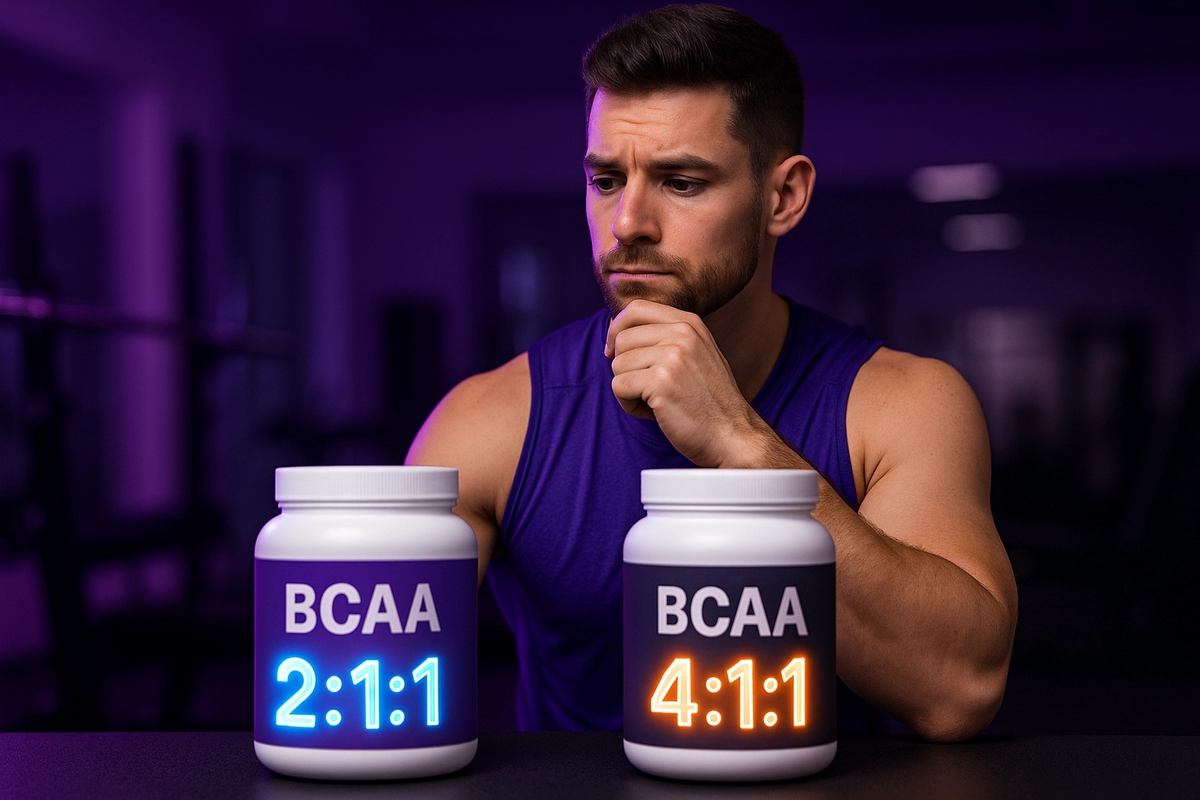Confused about which BCAA ratio builds more muscle—2:1:1 or 4:1:1? You’re not alone. This debate shows up in every supplement aisle.
Some say more leucine means more gains. Others stick with science-backed balance. So what’s the truth? I’ve tested both—and coached clients through every goal from cutting to bulking.
In this article, I’ll break down what actually works, share real-world results, and help you decide the best BCAA ratio for your training style.
Quick Answer – Which Ratio Works Best?
If you’re wondering which BCAA ratio delivers better results, I’ll get straight to the point:
2:1:1 is the most effective and reliable choice for most lifters.
It’s backed by science, proven in real training scenarios, and trusted by coaches and athletes worldwide.
Yes, 4:1:1 looks more “powerful” on paper with extra leucine—but more isn’t always better.
If you want to learn how to dose BCAAs effectively, especially during cutting, check out my full BCAA dosage for cutting guide.
Understanding BCAA Ratios – What Do They Mean?

BCAAs, or branched-chain amino acids, include leucine, isoleucine, and valine.
These three essential amino acids play a key role in muscle recovery, performance, and preserving lean mass—especially during calorie deficits or fasted workouts.
In a 2:1:1 ratio, leucine is double the amount of isoleucine and valine.
In 4:1:1, leucine is four times more concentrated.
Leucine is often seen as the “hero” because it directly stimulates muscle protein synthesis.
But that doesn’t mean the others are less important.
Isoleucine helps with glucose uptake and energy, while valine assists with focus and muscle endurance—which is crucial for runners and endurance athletes.
Science-Backed Benefits of 2:1:1 Ratio
In my 10+ years of training and coaching, 2:1:1 has always been the most balanced and effective ratio.
I’ve personally used popular 2:1:1 formulas like Scivation Xtend and ON BCAA 5000 during both cutting and bulking phases.
What I noticed? Smoother recovery, less muscle soreness (especially after leg day), and better energy between sets.
One of my clients, Sofia from Greece, followed a CrossFit program using only 2:1:1. She told me she could bounce back from intense workouts much quicker.
This ratio works well because it reflects the natural ratio found in complete proteins.
It’s also what most scientific studies use when testing BCAA effectiveness.
For those wondering about BCAAs vs complete proteins, you can read the full comparison here: BCAAs vs Protein Powder – Do You Still Need BCAAs?
Claims Behind 4:1:1 Ratio – Does More Leucine Help?

Let’s be real—leucine is the MVP when it comes to building muscle.
So, does more leucine mean faster gains?
Not necessarily.
I tested a European 4:1:1 product during a cutting cycle. While it gave me a slight mental kick in the beginning, that edge faded quickly.
By the end of my workout, I felt a bit more drained. Plus, I started noticing bloating and occasional light headaches.
Later, I realized I was taking in too much leucine—something I explain in my article about BCAA overdose and side effects.
Another client of mine, Marc from Belgium, also experimented with 4:1:1 during prep. He mentioned his joints felt “drier” and that recovery didn’t feel as complete.
The takeaway?
Overloading leucine might actually suppress the benefits of isoleucine and valine—breaking the synergy BCAAs are meant to provide.
Who Might Benefit from 4:1:1?
That said, 4:1:1 isn’t useless.
There are some specific cases where it might be worth testing.
If you’re:
- Training fasted daily
- Deep in a calorie deficit
- Or an advanced lifter hitting two-a-days
…then the extra leucine might help you preserve muscle a bit more aggressively.
In these scenarios, 4:1:1 could offer a short-term benefit.
Still, I’d pair it with timing strategies like those I cover in BCAA before vs after workout or even using BCAAs on rest days to avoid wasting the potential of the supplement.
Final Verdict – Which Ratio Should You Choose?

Here’s what I tell all my clients:
- Beginners to intermediate lifters: Stick with 2:1:1. It’s proven, balanced, and reliable whether you’re cutting, bulking, or maintaining.
- Advanced lifters or competitors: You can test 4:1:1, but do so with purpose—and monitor how your body responds.
For my own use, I rely on 2:1:1 combined with creatine and glutamine during longer or heavier sessions.
If I’m training fasted or doing early-morning cardio, I mix it into water with electrolytes. It really helps me preserve muscle and reduce soreness. I talk more about this in my guide to BCAAs for fasted cardio and fat loss.
Want to learn how to mix BCAAs for best absorption and taste? I’ve covered that too in this article: How to Mix BCAAs Properly.
And if you’re confused whether to go for BCAAs, EAAs, or full protein powders, here’s a full breakdown: EAAs vs BCAAs vs Protein Guide
FAQs About BCAA Ratios
Technically yes, but there’s no real benefit. It’s better to choose one ratio that aligns with your training goal.
I prefer them before or during fasted workouts. If you’re training in a fed state, whole protein usually covers your needs.
More on this here: BCAA before vs after workout
Not always. But during cutting, fasted training, or low-calorie phases, they can definitely help. I recommend checking this detailed guide: Do You Still Need BCAAs?
Yes—especially if you’re in a calorie deficit. Even on non-training days, BCAAs can help with muscle preservation. Here’s how I do it: BCAAs on Rest Days – Timing Tips
Final Word:
Don’t get overwhelmed by marketing numbers on the label.
Focus on what actually works in the real world—and what’s proven by science.
The 2:1:1 BCAA ratio remains the gold standard for a reason. I’ve tested both ratios, and seen firsthand how each performs under real training demands.
Trust your body. Train smart. Fuel with purpose.
You’ve got this. 💪



Leave a Reply